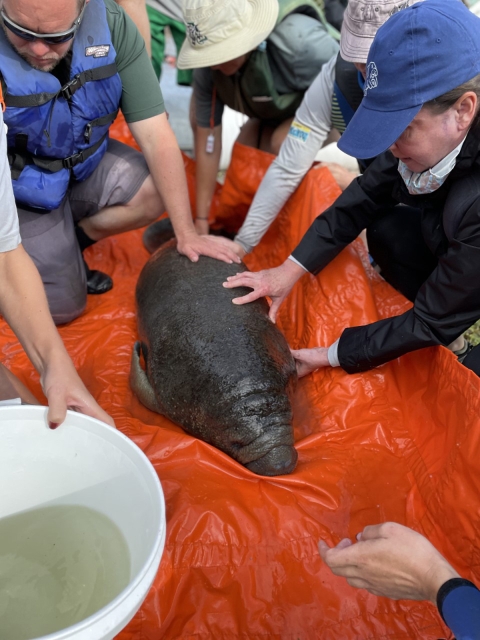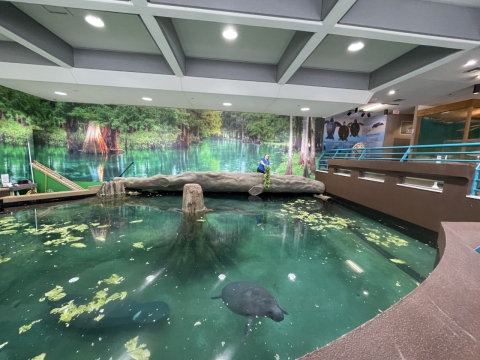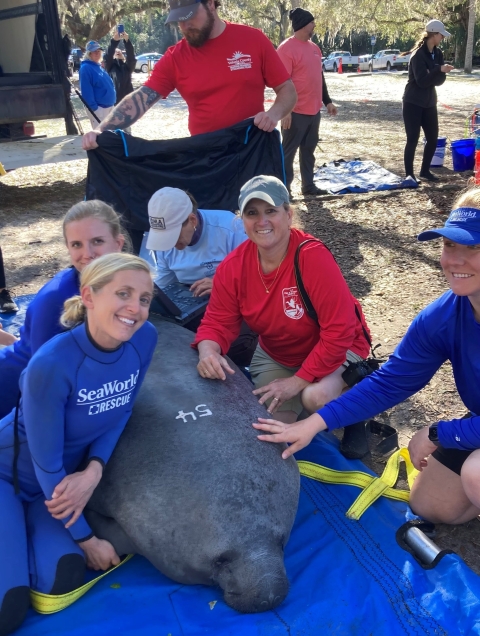Gentle 1,000-pound, 10-foot Florida sea cows are fascinating.
“Nowhere in the U.S. Fish and Wildlife Service are successful partnerships more evident than right now in manatee conservation. When we call organizations and volunteers to help manatees, nobody says no. The response is usually, ‘Just where and when do you need us’,” says Terri Calleson, Florida manatee recovery coordinator in the Florida Ecological Services Field Office.
Terri joined the Service’s Florida Ecological Services Field Office in 2009. Since then, she has seen manatee recovery and rehabilitation involvement grow from just a few partners that include the Service, the Florida Fish and Wildlife Conservation Commission (FWC), and rehabilitation facilities like Sea World Orlando, to a core group of over 20 organizations called the Manatee Rescue and Rehabilitation Partnership (MRP). Established in late 2001, the MRP is a cooperative of agencies, organizations, and oceanaria working together to rescue, rehabilitate, and release manatees back into the wild.
The Atlantic Coast Unusual Mortality Event
Since December 2020, manatees have faced starvation in what has been declared an Unusual Mortality Event (UME) due to the decline of seagrass in the Indian River Lagoon on Florida’s Atlantic coast. The Service and FWC continue to investigate a high level of manatee mortalities and respond to manatee rescues along the Atlantic coast of Florida. Responding to live manatees in need of rescue is a top priority for wildlife agencies and partners from the Manatee Rehabilitation Partnership.
As mortalities exceeded the state's ability to respond to both rescue and recovery of manatees, a Unified Command (UC) was established between the Service and FWC to collaborate on the UME response. The UC’s operations encompassed all of Florida’s Atlantic Coast from the Georgia/Florida line to Key West. Priorities for the UC focused on manatee rescue and rehabilitation, carcass recovery and necropsy, UME Investigation, Manatee Rehabilitation Partnership, and a Temporary Field Response Station.
During the winter of 2021/2022 and 2022/2023, a supplemental feeding trial for manatees was instituted in an area of Brevard County, Florida, close to a warm water site where they are known to congregate during colder weather. The supplemental feeding trial was conducted in order to try and minimize mortalities and the number of manatees that might need rehabilitation. Over the course of the two winters that the supplemental feeding trial took place, manatees were provided with more than 600,000 pounds of lettuce, primarily romaine, from mid-December through the end of March. Groups helping the Service with the supplemental feeding effort include FWC, Florida Power and Light, and several local organizations. Private donations through the Fish and Wildlife Foundation of Florida paid for most of the lettuce.
Critical Care for Manatees
Places providing critical care for manatees, such as Sea World Orlando, provide the treatment largely out of their budget and only receive reimbursement for a small percentage of the total cost. Prescott Grants awarded to conservation organizations and state agencies over the years have helped to foster the Service’s relationship with partners by providing needed support for their marine mammal response efforts. In 2022, the Service provided over $1 million to our partners via the Prescott Grant Program. Awards for 2023 will be announced later this year.
All told, the total manatee rescue, rehabilitation, supplemental feeding trial, and other response efforts for just the Atlantic Coast UME have involved over 700 people from more than 50 organizations. That’s quite a village of partners!
The Path Ahead
The need for seagrass restoration along the Atlantic Coast from Florida’s East Central coast through the Florida Keys is paramount. This lack of foraging habitat has contributed to a high number of manatee deaths since 2020, as well as leading to an increasing number of emaciated manatees in need of rescue, rehabilitation, and critical care. Improving water quality will be essential for the restoration of healthy seagrass communities. Numerous partner organizations are actively working together in that endeavor.
Another essential component of the UME response has been the overwhelming need for medical care for the manatees that have been impacted. Since the UME was declared in 2020, Terri has spent a lot of her time working with the MRP, the Division of Management Authority, and agencies such as the Department of Agriculture to help secure more rehab space for manatees in need of care and treatment. With a love and devotion that runs deep for manatees, it’s in Terri’s nature to keep fighting the good fight for these gentle giants.
“I opted for manatees after working the summer before graduate school at Sea World of Florida where I saw many manatees coming in for help. At that point, I decided it would be manatees, and that is where I would focus my efforts and try to make a difference, which for me has been what it’s all been about,” she says.
The Power of Partnerships
Having worked for other manatee partners in the past, Terri, and others like her in the Service, are keenly aware of the need for a network of trusted partners in protecting and recovering threatened and endangered species. The determination of our partners, combined with their visionary and innovative actions, provides us daily with the contributions needed for the success of the Endangered Species Act (ESA).
The ESA provides a critical safety net for fish, wildlife and plants and has prevented the extinction of hundreds of imperiled species, as well as promoted the recovery of many others, and conserved the habitats upon which they depend. A highly effective law, the ESA is credited with saving 99% of listed species from extinction.
As the ESA turns 50 years old this year, we celebrate the law's importance in preventing extinction and promoting recovery of threatened and endangered species. And most importantly, we celebrate the invaluable partnerships that help make recovery possible!









